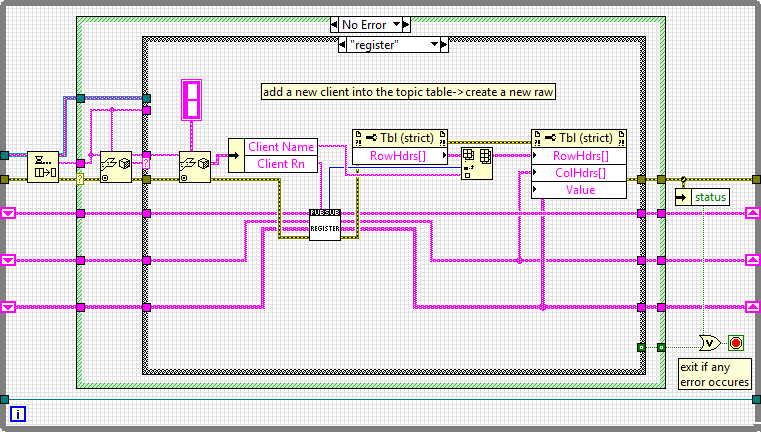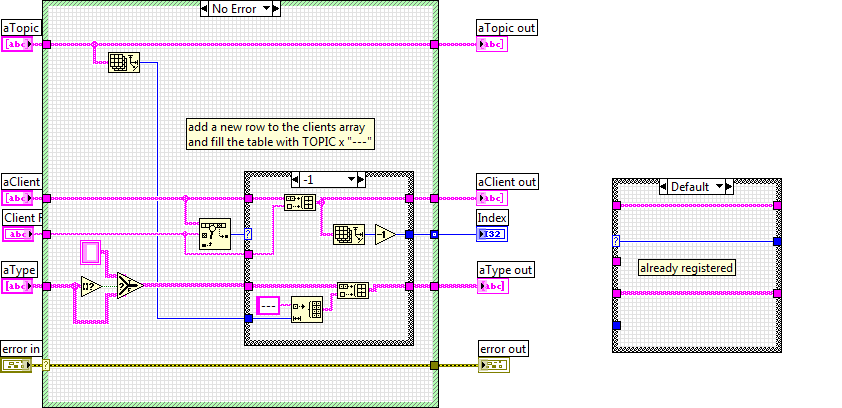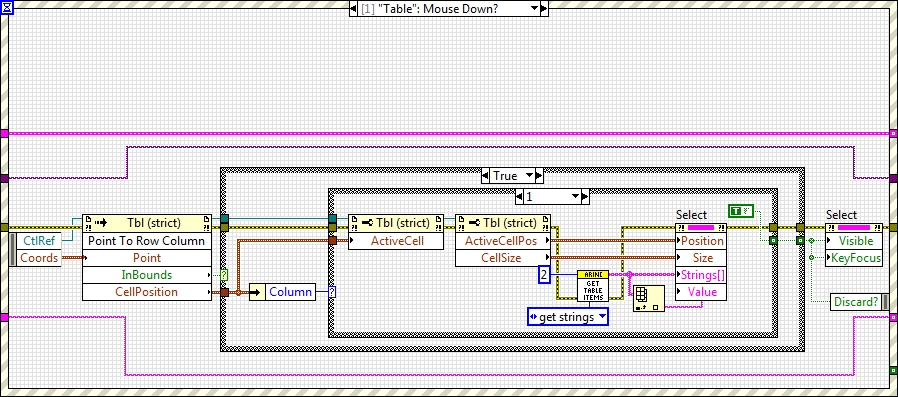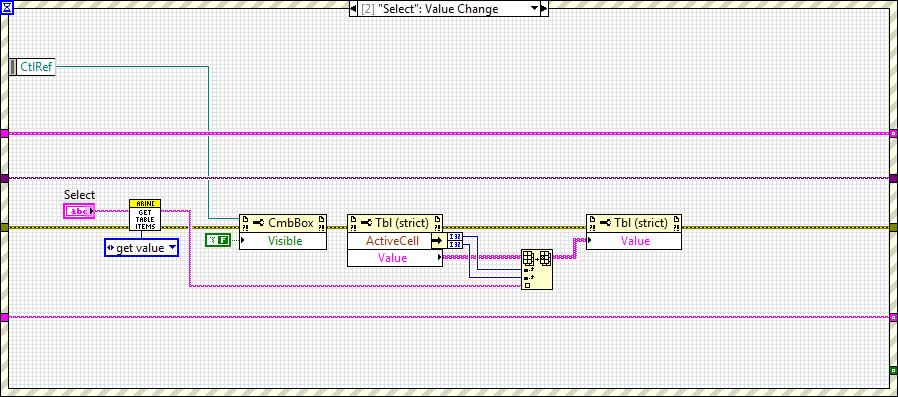-
Posts
432 -
Joined
-
Last visited
Content Type
Profiles
Forums
Downloads
Gallery
Posts posted by Eugen Graf
-
-
I think this site is great and just funny.
Currently I live about 10+ years in Germany and work for a half-military european company. It's very good the "Cold War" doesn't more exist and a globalisation of the world is growing.
Eugen
-
Hello LAVAs,
please look this site, it's very nice to understand Russia (if you want)
Eugen
-
-
-
What do you think about this article? Please comment, I need it.
http://www.labviewtutorial.eu/en/index.php...1&Itemid=93
Thank you
-
QUOTE (shoneill @ Jul 10 2008, 05:52 PM)
Assuming all the code is on one machine, why not use user events with multiple subscribers registering for the event? In effect it's similar to a notifier but with the ability to work via an event case instead of a function.It gives you essentially a 1..n link, albeit without the Queue (backlog) part.
Sample VI Attached (LV 8.2.1).
PS I just realised I forgot to destroy the two user events when the program finishes.... Oops
Yes! But UEs have some disadvantages:
I can't get status of UEs (need count of elements in my programms)
But for this one issue of course it's right alternative.
My implementation of Client Registration is like yours
QUOTE
So when we open a named queue, we look for a match of that name.You also check the name of the Queue. Ok, but what will happen if two or more "clients" want to use the same name?
In this case I compare the queue reference number, not the name of the queue. Is it a good sugesstion to improve your registration process?
-
Very nice video for LVOOP beginners, very easy to understand.

Thank you
-
QUOTE (Ale914 @ Jul 9 2008, 09:47 AM)
I use it when i need to dispatch message around the code from one point to different parallel loop for example suppose a quit message or acquired data to send to datalogger and to data viewer simultaneouslyCiao
If it's only this use-case, than you not really need the overhead, you done in our example. It can be much easyer, like in my first suggestion, where you open all needed queues at the begin of the programm, and close all at the end of the programm. So each parallel loop can send to each other, bacause each loop get all queue references as input.
-
What is to open to see the principle? Do you have an example VI ?
Do you use a "Array-DB" as container for all created queues?
P.S. sorry, I see now two example VIs
Ok, say me please when do you use this?
And if you want, you can look on this http://www.labviewtutorial.eu/download/file.php?id=655
And more complex and more universal this one http://www.labviewtutorial.eu/viewtopic.php?f=19&t=9
Regards, Eugen
-
New LAVA statistics are available:
Our members have made a total of 55461 posts
:thumbup:
-
QUOTE (wesramm @ Jun 27 2008, 08:48 PM)
I have the need for this functionality and am playing around with the alignment of the combo box on the table. Did you have to customize the combo box itself to achieve good registration with the table cells below? At best, my first cut looks poor. Your's looks nice.. Any tips?Wes
No, I didn't customize Combo Box. I try always to use System Controls, not theese from LabVIEW Classic or Modern Palette.
-
-
Want to paint my LV BDs in 3D

-
QUOTE (ragglefrock @ Jun 25 2008, 12:03 AM)
The question's a little confusing. How are you using your LVOOP class in C++? Are you calling a LabVIEW-built DLL that creates and uses LVOOP classes?To flatten the LVOOP class appropriately, you will need to use the LabVIEW Flatten to String function. You can create a wrapper VI that calls this function with a class input and create an exported DLL function to call this from C++.
I think to create a structure (=cluster) in C++ with all elements what LVOOP Class Contol Cluster has, than cast them to binary string (or byte array) and send over TCP/IP.
-
Hello LAVAs!
I want know if it's possible to flatten a LVOOP Class to a binary string from e.g. C++, so I can unflatten them in LV to a LVOOP Class ?
Thanks, Eugen
-
I think it's something for X-Controls CR

-
QUOTE (neB @ Jun 24 2008, 06:33 PM)
Ring>>> Mouse Leave Event hides ring?Ben
QUOTE
As soon as you hover the options you will get a mouse-leave event.This can be triggered by just clicking the control.But hey a ring control has two super-duper events:'Activated' this one gets triggered as soon as the control is clicked'Dismissed' if the Activated event is well ehm dismissedTonI use Combo Box, because I can change the Size of this control to the size of the table cell. Can I hange the size of a ring control? I didn't find this property.
P.S. and here is the Front Pannel of the VI.
-
QUOTE (Justin Goeres @ Jun 24 2008, 06:18 PM)
In my experience, things like this are really tough to implement because there are lots of weird things that can happen after you display the ring control.The first one off the top of my head is what happens when the user pulls down the ring control, but instead of clicking inside it to select something, they click outside it? Normally, that's the behavior when the user wants to cancel what they were doing and exit the item selection without changing the current value of the selector. How do you handle that case?
I'm asking not because I have an answer, and not because I think there's not an answer -- I just mean that the answer isn't obvious to me right now, but your users will expect it to work that way. I've historically found that replicating all the expected behaviors in a LabVIEW control is really hard if not impossible. If you've got a solution, I'd be really interested to hear it.
-
Ok, thank you, I just made it.
-
Hello, does anybody know if it's possible to make something like this in LabVIEW ?
Thank you
-
QUOTE (Yen @ Jun 14 2008, 09:54 PM)
I don't understand what it is you want to do. If you want to change the output based on the type of the input the easiest and most reliable way is to use a polymorphic VI.Another option is to just use DBL which should cover most other representations, I believe. OpenG has a function which does exactly this and accepts DBL. It might have polymorphic versions, but I don't think it does - the cleanest thing is probably to output the double value and then convert it after it leaves the subVI.
Yeah, polymorphic VI is the right solution for this, I think.
Thank you, Yen
-
Hello,
I have to generate a random unsigned integer from 0 to max. possible.
So I take "Random Number 0-1.VI" and multiple it's output with eg. 65536 (for U16). Ok, but if I would change the representation to U32, so I want programmaticaly know that I have to take 2^32 for my max. value.
Is it possible to get the representation of the wire? Should I flatten it to binary and use type string for it?
Here the screenshot
-
Thank you. So if I have NO inheritance in my LVOOP project, than it's always better to use static dispatch.
I should use dynamic dispatch first if I have some child classes ?
-
Why to use static dipatch member VI? It has only disadvantages to the dynamic dispatch member VI. Do it have less overhead for LV?







About Russia
in LAVA Lounge
Posted
Here some more about the language:
Scumbags’ slang
Thank you for loving Russia :thumbup: